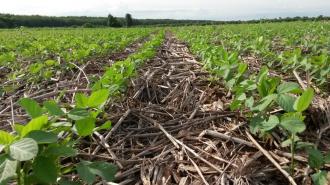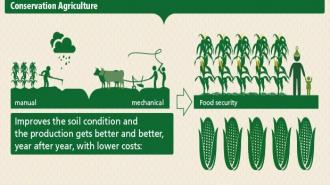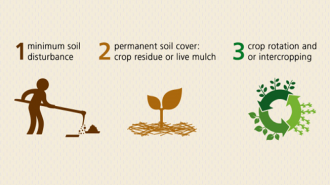CA - A Step Towards Sustainable Agriculture
Not many years ago, my great grandmother shared me that we used to have huge agriculture productions, while from the same field nowadays we are having trouble to compensate the costs of cultivation and inputs. Sometimes, she used to urge my parents not to indulge in agriculture rather leave the field barren or accord for rent. There was one thing always striking in my mind,” What might be the reason behind the dramatic fall of the productivity of the land?” After few years being an agriculture student, I got to know all the pretty little secrets of my outrageous thoughts. Green revolution and degradation of soil were the reasons for the pitfalls.
Huge food scarcity, economic and social instability jeopardized the lives of millions during the 2nd world war. Fast growing varieties of rice and wheat were developed for tropics and subtropics with high input agriculture system that produced more crops per unit of land. This is called Green revolution. But lack of water, high costs for small farmers and physical limits to increasing crop yields dissuade expansion of Green revolution. Moreover, it has a greater harmful environment impact than any human activity.
Therefore, the concept of Conservation agriculture and sustainable agriculture were introduced for long term increase in yield and output stability while at the same time stopping and reversing land degradation and environmental hazards.
On going through the literal meaning conserving and sustaining is somewhat alike in the sense that conservation eventually leads to the sustainability. But technically Conservation agriculture and Sustainable agriculture are distinct.
Sustainable Agriculture:
Sustainable agriculture is a balanced management system of environment resources without their depletion to provide food, livelihood for current and future generation maintaining or improving productivity and ecosystem service of these resource. It has 3 key principle:
- Economic sustainability : e.g. improving soil management and crop rotation which raise yields, reducing reliance on machinery, chemical fertilizer and pesticides
- Environmental sustainability: e.g. protecting, recycling, replacing and maintaining the natural resources base such as land (soil), water and wildlife Avoiding synthetic chemicals known to harm the environment, soil structure and biodiversity
- Social sustainability: e.g. more extensive use of available labor, at least for some techniques, thus contributing to social justice and cultural cohesion
Researchers have found that organic system on average yielded 25% less than the conventional. Moreover, the products fetch higher prices which is not affordable by the have-nots. Therefore, Sustainable agriculture has many ups and downs to serve for food security.
Conservation Agriculture:
Conservation agriculture was evolved from the concept of Resource Conservation techniques (RCTs) which refers to those practices which enhances resource or input use efficiency. Example: new variety that use N more efficiently may be considered as RCTs. In contrast, CA practices will only refer to the RCTs with following character:
- A minimum level of soil disturbance.
- Soil cover, particularly through the retention of crop residues on the soil surface.
- Sensible, profitable crop rotation
Benefits of CA are of several folds.
- Economic benefits:
By not tilling the soil, farmers can save between 30-40% of time, labor and fossil fuels as compared to conventional cropping. Reduction of costs and higher output for a low input are the major economic benefits.
- Agronomic benefits:
It includes increase in organic matter, soil water conservation, improvement in soil structure, fertilizer use efficiency, water holding capacity.
- Environmental benefits:
It includes reduction in soil erosion, good quality of air, water, increase in biodiversity, carbon sequestration.
Conservation agriculture (CA) aims to conserve, improve and make more efficient use of natural resources through integrated management of available soil, water and biological resources combined with external inputs (herbicides, fertilizers ... ) . Conservation agriculture is by no means a low output agriculture and allows yields comparable with modern intensive agriculture. Therefore, facing climate change and nine billion mouths to feed by 2050, Conservation Agriculture is key to the future of food security. Integrating organic principles to conservation agriculture contributes to environment conservation as well as enhanced and sustained agriculture production. Due to some deterrents for the adoption of Sustainable agriculture, Conservation agriculture can be flourished as a modern agriculture practice that can enable farmers to achieve the goal of sustainable agriculture production.
I am sure that I am not the single piece in the world whose parents are going to accept the suggestion by their grandparents that I have already mentioned above. Thus, we ought to produce more food from less land by making more efficient use of natural resources and with minimal impact on the environment. Only by doing this will food production keep pace with demand and the productivity of land be preserved for future generations. We have a tall order challenge and by We I mean all the agriculture scientists, extension personnel and farmers. In my prospective, Conservation Agriculture with sustainable principles is the most possible solution to meet food security and resource conservation.

Copyright 2019. All rights reserved



